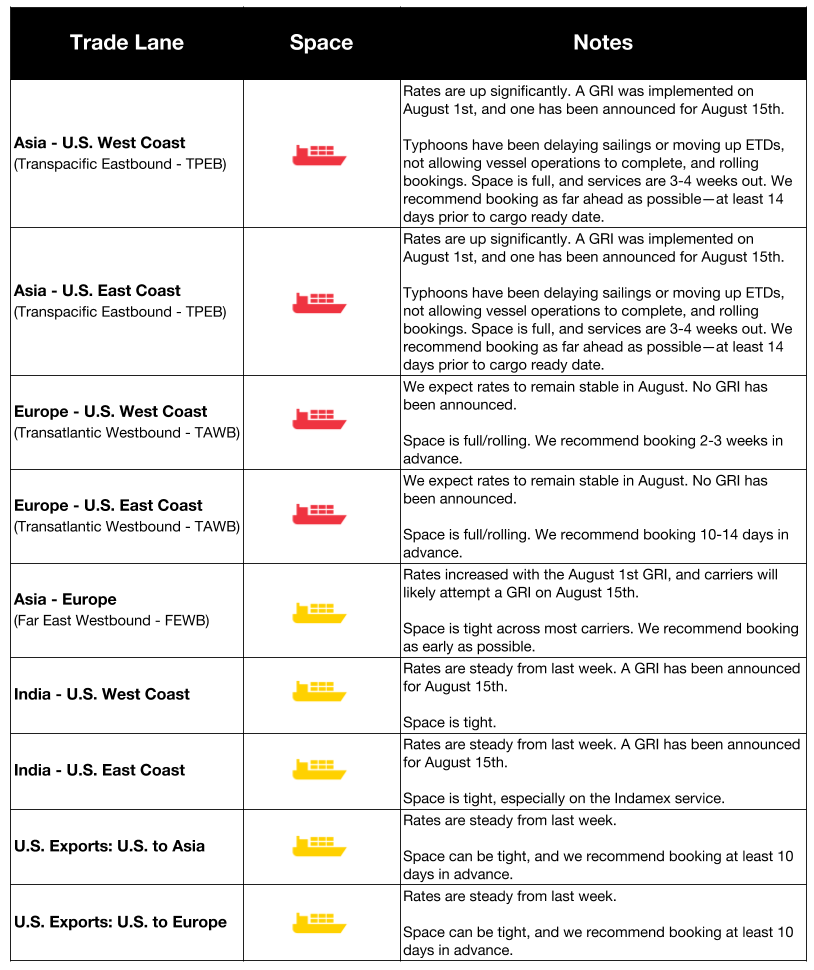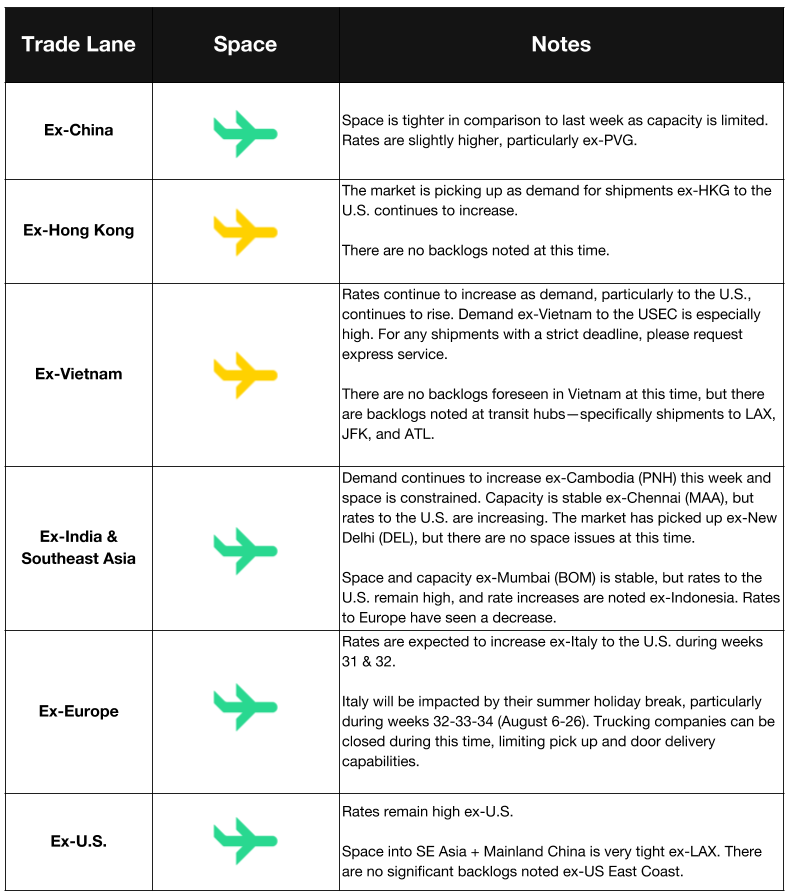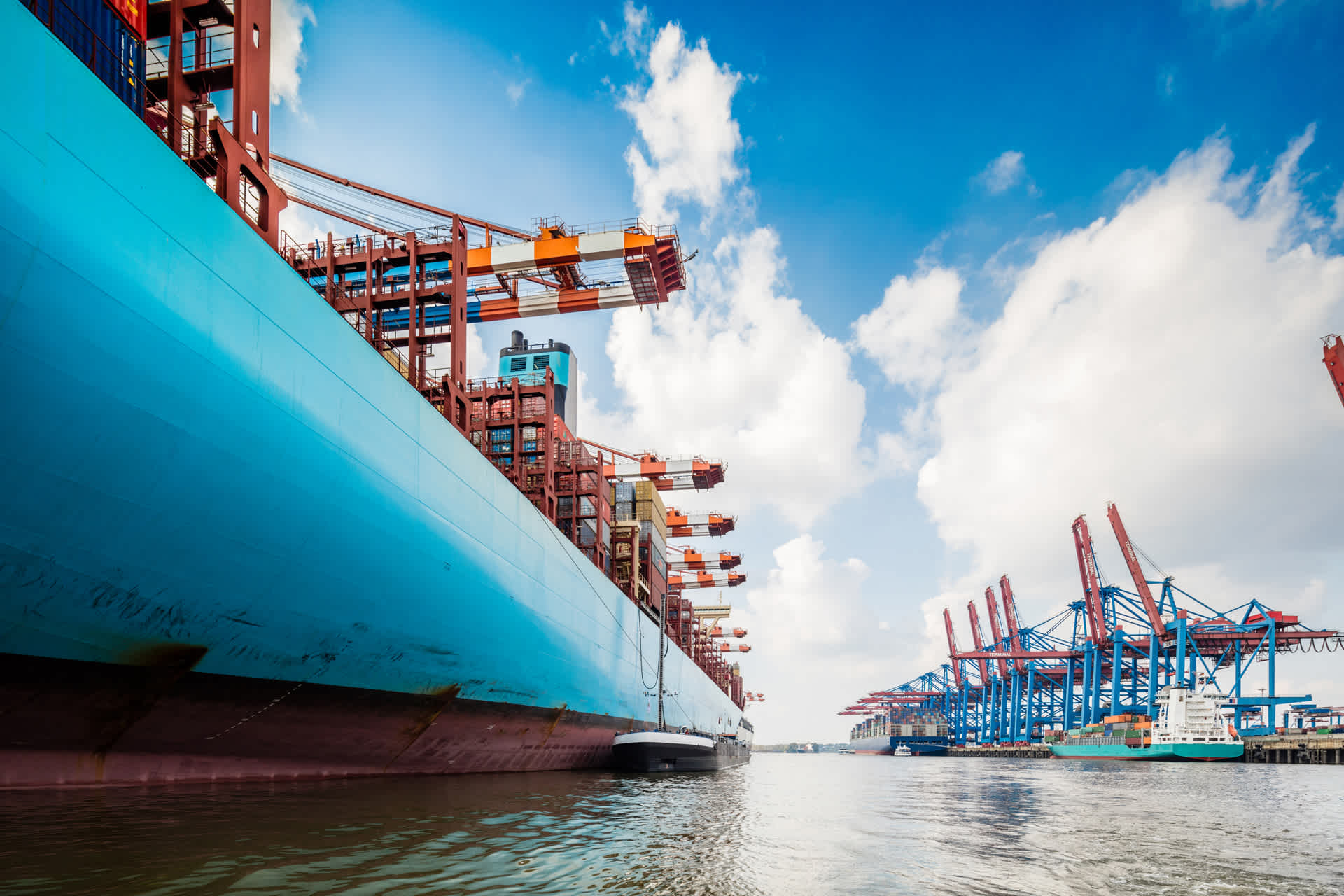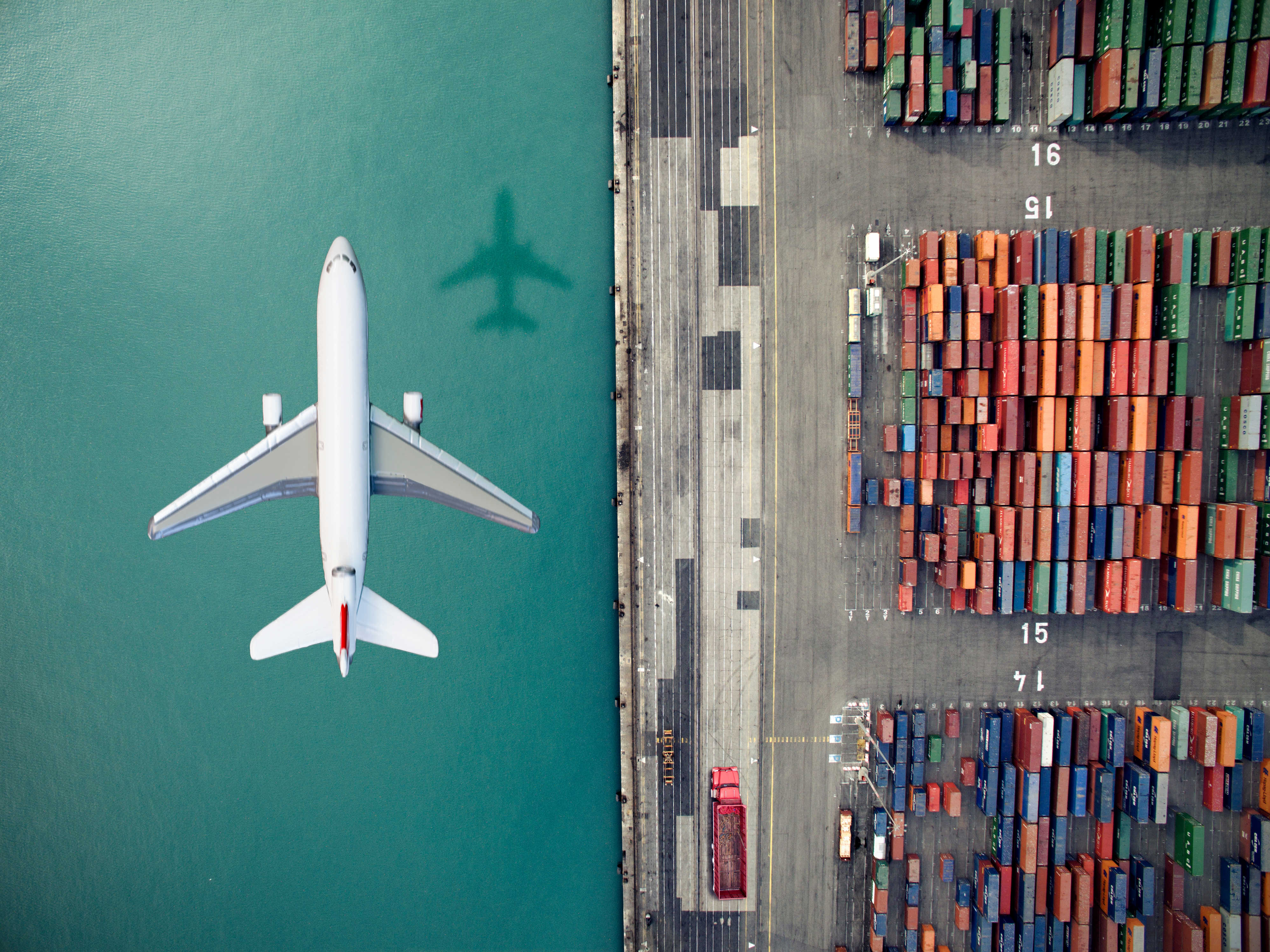Global Logistics Update
Freight Market Update: August 1, 2018
Ocean, trucking, and air freight rates and trends for the week of August 1, 2018.
Freight Market Update: August 1, 2018
Want to receive our weekly Market Update via email? Subscribe here!
Ocean Freight Market Updates

Peak Season Came Early This Year
U.S. import volumes are increasing ahead of the holiday retail season for a number of reasons, including:
- Capacity cuts and service changes
- Tariff deadlines
- Slow Q1 & Q2
Read the full analysis from Flexport’s VP of Ocean Freight here.
White House Says it’s Considering Higher Tariffs on Consumer Goods
The White House recently said it’s considering raising the most recent round of tariffs on $200 billion of Chinese goods from 10% to 25%. The final rate won’t be decided until September at the earliest.
Related blog post: What the Newest Round of Tariffs Means for Consumer Goods Brands
Carriers Push for ‘Hefty’ Spot Rate Increases
Spot rates and import volume have been increasing ahead of predicted levels, so carriers are pushing for spot increases of $600 to $1,000 per FEU in August and September. This is most evident for East Coast imports.
High Capacity at Port of Antwerp Causes Delays for Shippers
North Europe’s hub ports are reporting record volume growth, with the Port of Antwerp reaching its maximum capacity. The record growth is causing lengthy delays for shipments as containers move from deep-sea terminals to inland destinations.
High volume is placing pressure on the intermodal network, causing rail delay, road bottlenecks, and barge congestion. Shippers should expect delays and move schedules up accordingly.
**Trans-Pacific Peak Season Sees Higher Rates **
U.S. importers shipping in trans-Pacific should expect higher rates, as peak season has caused very low capacity on most ships. As JOC reports, “Ocean carriers in certain cases are holding the line on weekly minimum quantity commitments (MQC) as they have done in prior periods of tight capacity, meaning that any given shipper will be allocated only one week’s worth of capacity out of its total annual MQC.”
**TPEB Services Are 3-4 Weeks Out **
TPEB services are three to four weeks out, and we recommend booking at least 14 days in advance of the cargo ready date. Carriers are continuing to announce blank sailings and canceling services, which will likely lead to a tightening of the market and an earlier onset of peak season.
**Cosco Shipping Hit With Cyber Attack **
Last Tuesday, Cosco’s U.S. operations were the target of a cyber attack, which affected its ability to communicate with its vessels, customers, and marine terminals. This follows the cyber attack that targeted Maersk in June 2017 and cost the company as much as $300 million in revenue.
The attack on Cosco only slowed operations, as the carrier had “work-arounds” in place via phone and hard-copy transmissions. Operations have since been restored.
Impact of New IMO ECA Regulations
The International Maritime Organization has mandated under new Emission Control Area regulations that by 2020, all merchant vessels must reduce their sulphur emissions to 0.5% from 3.5%.
Whether they upgrade their vessels or their fuel, carriers will need to undertake significant changes to comply with the new regulations, and those changes will come at a cost to shippers. Rates may climb between now and 2020 as a result.
Air Freight Market Updates

Trade Dispute Hasn’t Yet Affected Peak Season Expectations for Air Freight
Air cargo expectations are still high for the “second half and into the end-of-year peak season” as the strong demand seen in the first six months is expected to continue. According to the JOC, volume has been steadily increasing in the east-west trades.
While trade relations may affect how goods move in the near future, there hasn’t yet been any change in consumer behavior.
**ELD Mandate Negatively Impacts Air Cargo **
The electronic logging device (ELD) mandate’s repercussions move far beyond the road, as air cargo providers are citing negative consequences. Higher trucking rates, delays, and even modal switches are some of the negative consequences for air cargo.
Related: The Electronic Logging Device (ELD) Mandate -- What You Need to Know
**Forwarders & Shippers Prepare for Low Air Capacity **
The 2017 capacity constraints for air freight aren’t forgotten in the minds of shippers and forwarders. In response to last year’s shortages and higher-than-usual rates, shippers are looking for guaranteed space throughout the year for their products, and some are looking for their own planes. Forwarders are chartering more flights to guarantee space and reserving planes for select shippers.
The Loadstar reports that demand growth is at 4-5%, and that April, which is usually the beginning of slack season, was stronger than expected.
Related blog post: Investing in Service, Flexport to Charter its Own Aircraft
Trucking Market Updates
**U.S. Truckload Carriers Predict Even Tighter Capacity Ahead **
With no indication that freight demand is slowing down anytime soon, trucking carriers are experiencing rapid revenue growth. As a result, shippers who don’t book in advance may be out of luck when looking for capacity.
**Big Rigs Get an Update Aimed at Efficiency **
Trucks are getting “smarter” as companies upgrade to new technology. From new tires to advanced navigation and communication systems, companies are looking for avenues to improve efficiency and lower the cost to serve.
Heavy-duty trucks are leveraging the internet to pull data from trucks with the goal of improving transit times and reducing the rate and impact of human errors. While the cost of upgrades can seem high, companies report that they’re saving money in the long run.
Trucking Analysts Expect Strong Earnings Reports in the Weeks Ahead
As capacity remains tight, truckers are able to set higher prices for shippers. Pair this with the high transportation demand and trucking companies’ investment in more efficient processes and systems, and it becomes clear why analysts expect strong earnings reports from the trucking industry.
According to The Wall Street Journal, “June marked the 16th straight month in which prices increased on an annual basis on trucking’s spot market, where shippers book last-minute transportation.”
Updated PierPass OffPeak System to Start in Fourth Quarter
On June 26th, members of the West Coast MTO Agreement (WCMTOA) announced that the program for providing extended gate hours (PierPass 2.0) has a planned start for the fourth quarter of 2018. A Q&A on the revised OffPeak program is available here.


